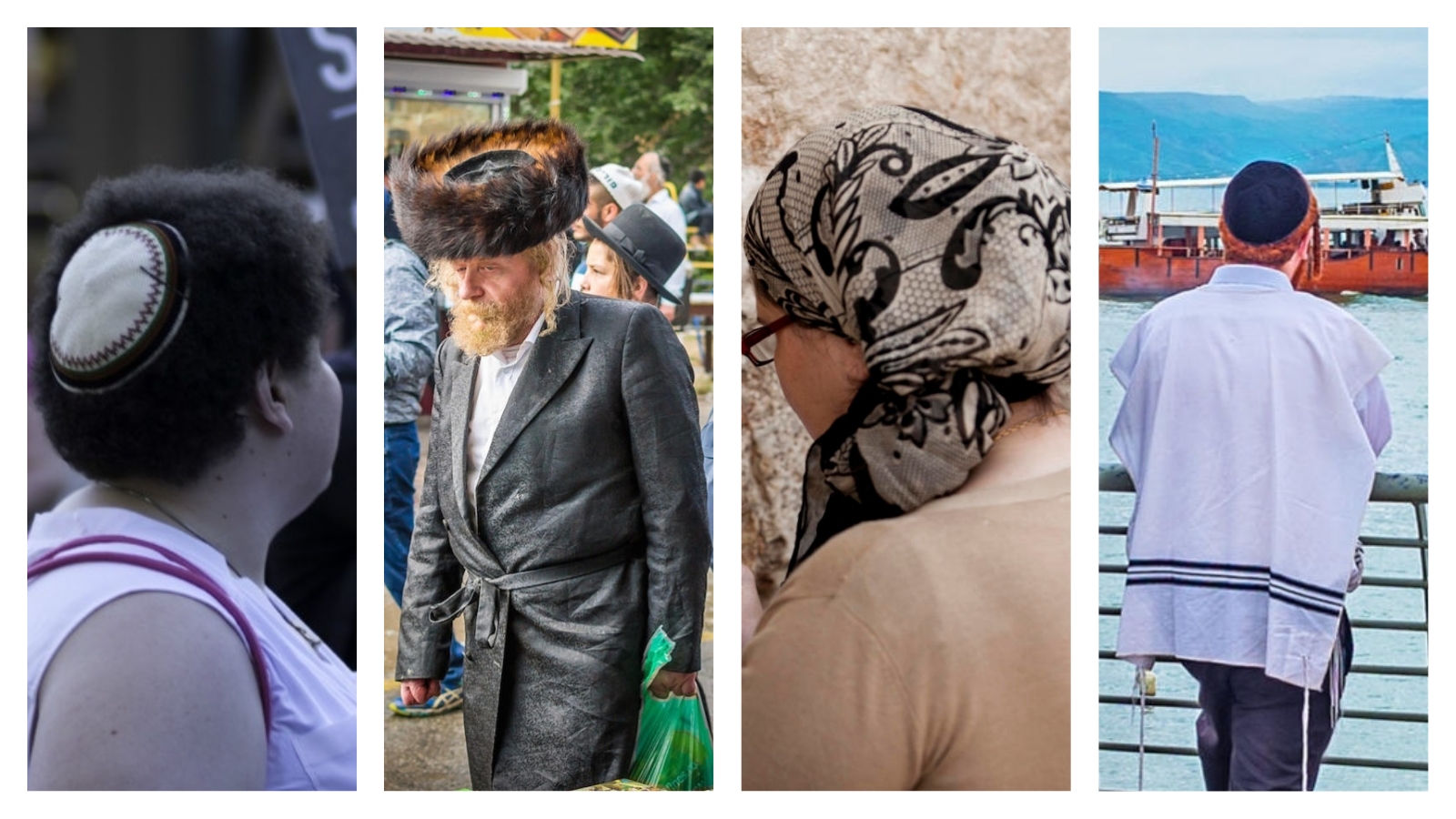Clothing has long played a significant role in Judaism, reflecting religious identification, social status, emotional state and even the Jews’ relation with the outside world. The ancient rabbis taught that maintaining their distinctive dress in Egypt was one of the reasons the Jews were worthy of being rescued from servitude.
Distinctive Jewish Garments Today
During synagogue services, Jewish men traditionally don prayer shawls and cover their heads with kippot, practices that some liberal Jewish women have adopted as well.

While most Jews dress similarly to non-Jews when outside synagogue, many Orthodox Jews are recognizable by their distinctive garments worn for reasons of ritual, tradition or modesty. In particular, Orthodox (and some non-Orthodox) men cover their heads with kippot, and some cover these with black hats or a shtreimel, a type of fur hat. More stringently Orthodox men often wear black suits, and many Hasidic men wear suits that are reminiscent of the style Polish nobility wore in the 18th century, when Hasidic Judaism began. Many Orthodox men also wear a tzitzit, a four-pointed garment with fringes on the corners, underneath their shirt — sometimes the fringes hang out from the shirt, but sometimes they are not visible.
With your help, My Jewish Learning can provide endless opportunities for learning, connection and discovery.

Many Orthodox women eschew pants and instead stick to dresses and skirts. In addition, Orthodox women generally wear modest clothes that cover much of their bodies, although how much is covered varies dramatically from community to community.
READ: Dare to Bare Those Ankles
In some ultra-Orthodox communities, women are discouraged from wearing bright, attention-getting colors. Once married, most Orthodox women cover their hair, whether with a hat, wig or scarf.
What the Torah Says About Clothing
The Torah says little about clothing, either descriptively or prescriptively. Without explanation, it prohibits blending wool and linen in a garment (such garments are known as shatnez), in the same verse forbidding “mixing” different seeds and species of cattle (Leviticus 19:19). It forbids men from wearing women’s clothes and vice versa (Deuteronomy 22:5), without specifying the characteristics of either. It also requires Jews to put fringes on the corners of a four-pointed garment (Numbers 15:37-41), both as a way of identifying the Jew and reminder reminding the Jew to observe the mitzvot.
On the other hand, the Torah provides extensive detail regarding the clothing of the priests, and particularly the High Priest, for their duties in the Tabernacle in the desert (Exodus 28), later adopted for the Temple in Jerusalem. Yet while the High Priest’s garb was elaborate, colorful and full of symbolism, for Yom Kippur, the one day a year he would enter the most holy portion of the sanctuary, he was to wear only white linen (Leviticus 16:4), a sign of humility. White clothing became the symbol of purity, and black a sign of mourning. Nowadays mourning is indicated by the tearing of a garment.
Jewish Dress in Ancient and Medieval Times
When the Jews were sovereign in their land in ancient times, the standard of dress of those who were wealthy, such as successful landowners, reflected their status. The nobility and upper classes dressed more elegantly. The styles of the neighboring peoples also had their influence. But when the Jews were exiled (70 C.E.) and lived under foreign control, the impoverishment of many Jews became evident in their dress.
In some cases, over time the Jews adopted distinctive dress voluntarily, to separate themselves from the prevailing culture. In others, they were required by law to dress in a particular way, e.g., special hats and badges in medieval Spain and 13th-century Poland. Jews of Eastern Europe came to adopt fashions of the early modern Polish nobility, such as the black robe (caftan) and the fur hat (shtreimel), which are still worn by various groups of ultra-Orthodox Jews.
The origins of men covering their heads with a hat or yarmulke (skullcap) are not clear. The Talmud relates several incidents where covering the head is considered a sign of submission to divine authority. Some attribute it to the Jews’ need or desire to differentiate themselves from Christians, for whom removal of the hat was a sign of respect. By the 16th century, it had become common enough to be codified as normative behavior among the more observant, who still cover their heads all day or at least during prayer and study.
For women, the uncovered head was from earliest times considered immodest, if not worse. Married women covered their heads so as not to draw the attention of other men. The sheitel (wig) worn by very religious married women is a relatively late variation on this. These practices are observed today only in very traditional circles.
Over the ages, rabbinic authorities often spoke out on two matters related to clothes– against excessive or gaudy styles and in favor of keeping clothing, particularly for women, “modest.” On the other hand, it has long been a custom for Jews to have special clothes for Shabbat and festivals, contributing to the special character of these days.
Hasidic
Pronounced: khah-SID-ik, Origin: Hebrew, a stream within ultra-Orthodox Judaism that grew out of an 18th-century mystical revival movement.
shtreimel
Pronounced: sht-RYE-mull, Origin: Yiddish, a large fur hat worn by Hasidic men.
Talmud
Pronounced: TALL-mud, Origin: Hebrew, the set of teachings and commentaries on the Torah that form the basis for Jewish law. Comprised of the Mishnah and the Gemara, it contains the opinions of thousands of rabbis from different periods in Jewish history.
Torah
Pronunced: TORE-uh, Origin: Hebrew, the Five Books of Moses.
tzitzit
Pronounced: TZEET-tzeet, or TZIT-siss, Origin: Hebrew, fringes tied to the corners of a prayer shawl.



